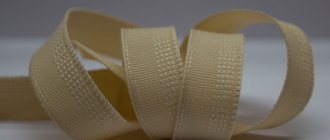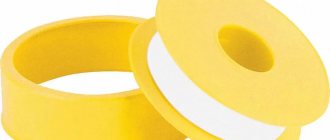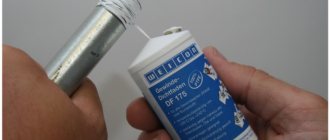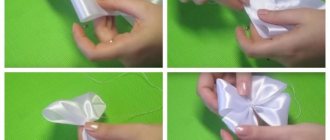When assembling a pipeline and installing various plumbing equipment, it is necessary to firmly seal the joints of pipe parts in order to avoid water or gas leaks. There are various materials for this. One of the most popular tools for sealing is FUM tape. Its use has its own subtleties and nuances, so you need to know how to wind FUM tape correctly so that no problems arise during the installation process.
FUM tape Source wellmart.net
How to wind flax on a thread. How to properly wind flax on a thread
Today, there are two most popular materials for sealing threads: fum tape and flax - also known as tow. Both materials for packaging threaded connections have both their positive and negative sides.
The advantages of flax for winding threads are low cost, durability in use and some other advantages. For example, flax swells when in contact with liquid and it often happens that a small leak heals the next day.
It is more convenient to work with tow and you certainly cannot do without it when winding cast iron threads and other threaded connections with large diameters.
To know how to properly wind flax on a thread, you need to remember the following:
Winding flax onto the thread is done clockwise, or in other words, along the thread, in the direction of its twisting.
- After sealing the thread with tow, its surface is lubricated with a special paste to prevent rotting during operation.
- To prevent the flax from slipping off the thread during the process of winding it, small notches are made on threads made of non-ferrous metals (bronze, brass, copper) using pliers or plumbing crabs. You don't have to scrape black metal.
How to lubricate tow for carving
If you don’t yet know how to lubricate tow for carvings, then you should understand that both special purchased pastes, such as “Unipak” or plumbing sealants, and other lubricants, in particular litol and grease, are suitable for these purposes.
It is not very convenient to work with the latest lubricants for tow, since you cannot wash your hands from them afterwards, and the effect on flax during its operation may not be as positive as when using special lubricants and sealants.
What is tow and how to work with it
Before fum tape appeared on the market, plumbing tow, which was flax fibers, was used to seal threaded connections of pipes. Optimal results were achieved by coating the layer of tow wound on the thread with a small amount of oil paint. Such a connection was difficult to disassemble after several years.
Now sanitary linen in the form of long silky threads is used along with new sealing materials. Only now a layer of sealing paste is applied on top of the winding, ensuring a reliable and durable connection. The paste protects the flax from rotting and makes dismantling easier if necessary.
Flax fibers are long, thin, strong, fit tightly into the grooves of the thread and do not deform when screwed
What is better tow or fum tape
Each material has its own advantages and disadvantages. Plumbing flax is used to seal joints of steel pipes (especially rusty and/or large diameter ones).
Advantages of tow:
- the ability to adjust the connection: unscrewing back by 45 degrees is permissible;
- reliable tightness: absorbs moisture well;
- resistance to mechanical stress;
- easy dismantling of the connection.
The disadvantage is the tendency to rot/decompose, since tow is a natural material.
It is preferable to use plumbing tape on small-diameter pipes, plastic pipes, and in the case of thin-walled fittings. It is easier to work with fum tape and takes less time to install.
There is no clear answer to the question: “Which is better – fum tape or sanitary linen?” It all depends on the specific plumbing job. For example, it is more convenient to connect a kitchen faucet with a flexible hose using fum tape, and it is better to seal a fitting on a water pipe using tow.
A better seal is achieved by winding a small amount of flax and then securing it with several turns of tape.
Product marking
The technical regulations define three markings for fluoroplastic sealants.
The remaining products are subtypes of the main names:
- FUM-1.
It is used as a sealant in general pipelines, in systems working with aggressive chemicals (calgon analogues for washing machines are written about in this article). Added lubricant to the composition – 20% petroleum jelly; - FUM-2. The material is used in pipelines containing substances with strong oxidizing properties. Lubricant is not included;
- FUM-3. Tape is used in communications with neutral media. Available without lubrication.
IMPORTANT! The material is destroyed at temperatures above 520 degrees. Doesn't burn, doesn't explode
Manufacturers guarantee shelf life within 10-13 years.
Material properties
The main advantage of fluoroplastic is its high plasticity.
In addition, the material is durable, non-toxic, chemically inert, and thermally resistant. FUM tape is capable of operating at pressures up to 40 MPa (relevant for antler baths).
The temperature range is minus 60 – plus 200 degrees.
When heated above 260 degrees, the structure of the material begins to deteriorate, and highly volatile fluoride compounds are released.
Average material characteristics:
- thickness 0.04 - 0.2 millimeters;
- width – 10, 15, 20, 60 millimeters;
- fracture tension 40 – 60 kg/cm2;
- lubricant content 0.3 – 20%;
- 100% elongation before breaking.
Proper Use
Knowing some of the features will help in creating a sealed connection (watch a video of alternative heating of a private house with your own hands on this page).
In turn, this will save you from the troubles associated with sudden leaks in the pipeline.
The following sequence of actions must be performed:
- the threaded connection is cleaned of debris and rust;
- parts included in the connection are degreased with gasoline or solvent;
- the material is wound onto the external thread in a clockwise direction. It is imperative to give the tape a slight tension, at which the fluoroplastic fits tightly to the thread;
- the end of the tape is brought out in such a way as not to interfere with the element being wound.
FUM tape is wound in several layers to create a tighter connection.
The number of turns depends on the diameter of the pipes (for water supply in an apartment).
When using products with a diameter of 15 - 25 millimeters, three full turns of the seal will be enough. As the size increases, more layers of fluoroplastic are wound.
To the touch, FUM tape is slippery and can cause inconvenience when working. The wound seal cannot be reused.
How to wind it correctly and how many turns of FUM tape you need to make on the thread, watch the video.
FUM1 tape is used to seal threaded connections. It is made from fluoroplastic grade 4D - a synthetic material; a thin elastic white tape is obtained by rolling out a rope. Most often it is used to seal pipeline connections. In this article we will look at how to wrap fum tape around a thread for a strong connection.
Also, read about alternative types of sealants: tangit-unilock and plumbing tow.
Characteristics of fum tape of three types
- FUM tape is produced in three types, depending on the place of its application. FUM tape grade 1 is a premium grade tape designed for sealing threaded connections in systems with an aggressive environment, for example, concentrated alkali or acid. This tape contains Vaseline lubricant, which increases its performance characteristics.
- Grade 2 tape is typically used to seal piping systems that handle strong oxidizing agents such as oxygen and does not contain the protective lubricant of petroleum jelly.
- FUM grade 3 is used in general type pipeline systems, but it can also be used in systems with potent agents. When using a tape of this brand, you should know that this type of tape is less reliable than the previous FUM brands 1 and 2.
To a large extent, the connection density depends on the correct winding of the FUM. How to wind fum tape onto a thread correctly, avoiding leaks?
Correct winding of fum tape onto the thread
First, clean the threads of dirt and rust before wrapping the fum tape. Then all parts of the pipeline should be wiped with solvent or gasoline. The FUM tape must be wound along the thread with careful movements.
Each turn of the FUM tape should partially cover the previous one. To prevent folds and wrinkles from forming on the tape and to ensure that it is wound smoothly, winding should be done with a slight tension.
We should not forget that the smoother the tape is wound, the more reliable the threaded connection will be. There is no need to move the roll of tape away from the winding point too much - the best option is when it fits closely to the thread.
When the tape is wound, you can screw the butt piece to the joint. When screwing, it must move with a certain force - at this moment the FUM tape fills the thread. For clarity, watch the video:
Fum tape winding technology
We offer step-by-step instructions:
- Thoroughly clean the surface of the thread on which the winding is to be performed. Remove traces of dirt, debris, and rust.
- Wipe all elements with gasoline or solvent. Proceed to the next step after the surfaces have completely dried.
- The tape should be wound from the end of the thread, moving towards its beginning. The direction of movement should be clockwise if the thread is right-handed; for left-handed threads, on the contrary, you need to move counter-clockwise.
- When winding, the tape must be kept slightly taut. This will ensure sufficient density and reliable sealing of threaded connections.
But do not overdo the tension on the tape to avoid causing it to break.
The sealing material is applied in several layers. The number of turns depends on factors such as the diameter of the pipe, the condition of the thread, and the quality of the fum tape itself.
For a pipe with a diameter of up to 20 mm, 3-4 turns will be sufficient; over 20 mm, up to 4-8 layers should be applied
.
It is not advisable to leave the end of the fum tape on the last turn of the thread; bring it out so that it does not interfere with the subsequent screwing of the connecting element.
Caution when using tape
There are a number of simple rules that will protect you from unnecessary and poorly performed work:
1. Winding must be done with a single piece of tape. Otherwise, the sealing will be broken and a positive effect from such winding of sealant on pipes will not be expected.
2. If you applied the tape incorrectly, tear it off and throw it away. Re-gluing the tape is not allowed, since the adhesive layer has already lost its original reliability.
3. If you feel that you have pulled the tape too tightly, it is better to completely unwind it and rewind it again. This way you will save yourself from unnecessary work in the future.
Now you know exactly what you need to pay attention to and how to properly seal at such an important stage of pipeline work as sealing
Varieties, alternatives and selection rules
Flax is good for laying almost all metal pipes, including cast iron, stainless steel, non-ferrous metals, including copper, and their alloys, such as brass. The only exceptions are aluminum and metal-plastic products, as well as those made from polymer compositions. For them, professionals recommend using fum tape.
Fibers of various qualities are available on sale. All of them are produced on the same equipment - a carding machine. They are distinguished by numbers, which contain a description on the label. They vary in the range from 8 to 24. In this case, fibers with a higher number will have fewer impurities and vice versa. They are also characterized by a degree of flexibility, which is less important in their work.
Fibers are packaged in coils, as well as braids of fixed weight and size. Their color can vary from white to light gray, as well as beige due to the use of natural raw materials.
Performance characteristics of the material
Fum tape is available in a wide range, so some performance characteristics may vary significantly.
When choosing, buyers are guided by the following:
- Plastic.
- Non-toxic. It is preserved at low temperatures. If the tape is heated to 270 degrees or higher, the material begins to release dangerous toxic compounds.
- Strength.
- Pressure. The operating pressure at which fum tape can be used while maintaining its original properties is up to 41.2 MPa.
- Operating temperatures. The products can be used in a wide temperature range - from –70 to +260 degrees, with full preservation of the original properties and safety.
- Anti-corrosion properties.
- Chemical resistance. The material withstands exposure to aggressive environments without losing its original properties.
Pros and cons of using
The main advantage of choosing tape is its availability. FUM is sold at a low price, cheaper than flax tow and most other sealants used in plumbing.
The material is characterized by ease of installation. With proper skill, winding the tape occurs in a matter of seconds, but for this you should practice winding it on connections of different diameters for some time.
An important advantage of using tape is that the parts fastened with it can be easily disassembled. The connections do not freeze tightly; they can be disassembled even years after installation.
The main disadvantage of the material is that it is not the most reliable of seals, therefore, as a rule, it is not used for industrial installation. However, for household repairs the hermetic properties of FUM are quite sufficient.
Another disadvantage is that the tape often protrudes outward from the joints, so the pipes may look sloppy because of this.
Tape on thread Source sdelairukami.ru
Using FUM for a gas pipeline
To fasten gas pipeline parts and install gas equipment, you should use only special FUM tape for gas. It must be supplied with a certificate of conformity confirming its suitability for use on gas pipes.
The special film for gas is yellow. It is made wider - up to two centimeters in width.
Yellow FUM tape for gas Source megastroy.com
The use of the material is possible only when sealing can only be achieved using a sealant. In the case of rubber hoses, as well as metal hoses, the sealing function is provided by a special gasket. In this case, the additional seal will not add tightness to the connection, and may even break it, as it will interfere with the tight fit of the gasket.
PTFE sealing material
FUM is fluoroplastic-4, PTFE (polytetrafluoroethylene), Teflon. Doesn't burn, doesn't rot. Warranty period – 13 years.
Resistant to aggressive industrial environments and domestic wastewater. Used for plumbing and heating. For gas pipelines it is used only if there is a certificate confirming suitability for these purposes (SP 42.101-2003).
The spread of such a sealant, especially in everyday life, is facilitated by the speed of operation and the absence of contamination after use. Here the question of choice - FUM or linen - was decided in favor of the tape.
Range
According to TU 6 – 05 – 1388 – 86, three grades are produced.
The third is edge trimmings of the main brands. Wavy, the cheapest material. When unwinding freely from the reel, it tends to form a circle.
The lubricant contained in grade 1 tape warns that when sealing cylinders and lines with oxygen, it will spontaneously ignite.
In practice - due to the appearance of imported tape - the size range is much longer. Experts recommend the following specific sizes:
- thickness 0.075-0.1 mm with a width of up to 12 mm when wound on threads 1/16 – 3/4”;
- thickness 0.12-0.2 mm with a width of 19 mm for large threads.
Markings on the reel must be present.
The yellow color of the tape itself indicates the possibility of using it for sealing gas pipes.
Terms of use
FUM or flax, which winds better? If you do this for the first time, it’s equally difficult. The tape itself is slippery. In the water - wet ice on wet ice, breaking.
This means that the joints must be dry, free of dust, dirt (flax is not afraid of this), and free of grease. You have to wind it with force. So that the tape stretches, but does not break through the sharp thread. With certain skills, working with tape is easier.
The number of turns depends on the diameter of the pipe and the thickness of the tape. Up to Ø 20 mm, 4 or 5 turns are made with 0.075 mm tape; above, up to 8 or even 10 turns are made with 0.1 mm tape.
But fluoroplastic is an elastic material. Greater thickness seals better, but vibration may cause the connection to loosen.
The first turn of the thread is left free - see photo of the bend and elbow.
Experienced plumbers twist the tape into a thread and fill the interturn cavity. This technique increases the rigidity of the joint.
FUM tape is wound along or against the thread: both methods must be tried. When winding counterclockwise, moving the fitting clockwise (right-hand thread) will collect the entire tape into a shapeless lump.
This leads to one serious drawback of the tape: during installation, the pipe, fitting or fittings need to be turned only in the direction of screwing and winding the tape. Turning in the opposite direction, even a few degrees, will crumple the tape. A leak is inevitable.
But in most cases it is necessary to set - adjust - the tap or valve to the desired position after full tightening.
If the first time it was not possible to combine the maximum tightening and the desired position of the shut-off or other valves, the pipeline elements must be disconnected. Remove the used tape and wind a new one. There can be five or eight such approaches, but it mainly depends on the master.
This is the answer to the question, what is better than flax or FUM tape for water supply, for example, in a country house. Len packs on the first try.
The next day, it is recommended to tighten the connection to the tape.
Can tape be used on compression fittings?
FUM tape, like thread sealants, is usually not used on compression fittings. In this case, the thread itself does not seal the connection. The sealing here occurs by compressing the slotted ring between the pipe and the nut.
Technical parameters and brands
Industrially produced fluoroplastic tapes and films are regulated by GOST 24222-80; the PN brand (non-oriented cushioning material) is used as an insulating sealing material; in accordance with the PN standard, opaque matte products from milky to light gray are used.
Tape sealing material made from the PN brand has the following parameters:
- It has excellent chemical resistance to aggressive substances and does not dissolve even in aqua regia - a mixture of concentrated nitric and hydrochloric acids.
- The produced film does not lose parameters in the temperature range from -269 °C to +260 °C, and is a low-flammable material with an ignition threshold of 520 °C.
- When heated above 260 °C, the polymer releases volatile toxic fluorine compounds.
- The material is gas-tight and an excellent dielectric - electrical strength 65 kV/mm.
- The tensile strength of the film in the longitudinal direction is 19.1 MPa or 191 kgf/cm2.
- The film has high elasticity, its relative elongation to break at any thickness is 185%.
- The material has no pores and has a low coefficient of friction.
- According to the above standard, the thickness of the PN film lies in the range from 0.2 to 3 mm, and the width is 40 - 120 mm.
Also, for fluoroplastic tape of grade 4D, made by rolling out a rope, the technical specifications of TU 6-05-1388-86 are adopted, which indicate:
- Scope of application: threaded connections of pipelines made of all types of materials operating in temperature conditions from -60 °C to +200 °C;
- Working medium pressure: up to 9.8 MPa (98 kgf/cm2), maximum permissible values - 41.2 MPa (412 kgf/cm2).
Rice.
5 Application area and dimensional parameters of produced FUMs FUM tape is produced in the following brands:
1 - for industrial working environments, as well as for equipment with chemically active substances - acids, high concentration alkalis, their mixtures and solutions. They are made of the first and highest grades, used with vaseline oils (17-20%) as a lubricant.
2 is a lubricant-free fluoroplastic sealant designed to isolate joints of oxygen-conducting systems or those with other active oxidizing agents.
3 - extreme sections of the first two tapes and the SKL film (wet calendered tape made of fluoroplastic F-4), for use in industrial pipelines, the working fluid of which is industrial components and chemically active substances in the form of concentrated acids, alkalis and their combinations in different proportions .
The main physical characteristics of FUM 1-3 used in the construction industry according to TU 6-05-1388-86:
- tensile strength, MPa: 6.86 and 4.9 for FUM-1 and 2.94 for FUM-3;
- elongation at break, %: 95, 80 for FUM-1 and 40 for FUM-3;
- thickness, mm: 0.1 -0.14 for FUM-1 and 0.12 for FUM-3;
- width, mm: 10 - 60 for the FUM group and 3 - 25 for FUM-3.
Rice. 6 Example of incorrect winding - large layer and channel overlap
Advantages and disadvantages over tow
Flax fiber remains one of the widely used materials for sealing joints on threads, but in many cases it is being replaced by FUM tape due to the following advantages:
- Unlike tow, which is saturated with water and requires additional protection (painting, putty), the fluoroplastic strip is waterproof and does not require additional consumables during installation.
- Sealing with fluoroplastic tape is characterized by simplicity and high speed of work.
- It is almost impossible to detect joints using flax fiber that have an aesthetic appearance - tow often protrudes beyond the dimensions of the joints, being located on the surface, has an inaccurate shape and is painted in conspicuous colors. The connection with the FUM is usually hidden under the fittings and is invisible to the eye; if necessary, it can be easily cut off or left on a light plastic pipeline without disturbing the decorative effect.
- Linen is a natural material and, when saturated with moisture, is susceptible to rotting and destruction; fluoroplastic can work in the system for decades without losing its physical and chemical parameters.
- For the reasons given above (painting after winding), the connection with a fluoroplastic insulator, unlike flax tow, is quick-removable - easy to dismantle without further work on cleaning the threads and surfaces of the parts being connected.
- When sealing tow, it is necessary to exert significant physical effort using plumbing wrenches - this can lead to destruction of the surface of fittings, adapter couplings, and union nuts. Due to its plasticity, when using fluoroplastic tapes, the applied forces are much less and allow you to connect parts even by hand.
- The commercial advantages of FUM tape should also be noted - it is easily accessible, it can be purchased at any building materials store or on the market, and the cost is comparable to the price of flax tow.
Rice. 3 Metric and pipe threads
Despite the rather significant advantages, FUM tape has not completely replaced tow for the following reasons:
- The material has insufficient mechanical strength, that is, when used on a metal thread, its surface can be easily damaged (cut) by the sharp edges of the teeth during winding - as a result, the tightness will be broken and the connection will begin to leak water. This drawback limits the use of FUM tape, which is not recommended for use on triangular metal threads with sharp teeth (Fig. 3); the most suitable types are pipe, trapezoidal and any type on plastic products made of polymers.
- The tape is more demanding on the thickness of the winding layer than flax tow; if there is an excess, the surface of the fluoroplastic sealant breaks, while the flax simply compacts.
- Despite its high heat resistance, FUM tape is not recommended for use in heating systems with steel pipes - due to thermal expansion, it is strongly compressed or squeezed out of the thread, and when cooled, it does not completely seal the connection, resulting in a leak.
- FUM should not be used when joining fittings that are subject to vibration during operation.
Fum tape instructions. Fum tape: main characteristics
The first development of fum tape began in the middle of the last century; since the late 80s, it has already been successfully used in hydraulic systems of industrial equipment. Since the early 90s, it began to be used for sealing various threaded connections, including at the household level.
Fum tape is made from 4D fluoroplastic and consists of thin threads bonded into an unsintered film. It is non-toxic, heat-resistant, and has anti-corrosion resistance. Fum tape, depending on the application, is produced in three brands:
- grade 1 – intended for sealing threaded connections of industrial-type systems and systems with highly aggressive media, contains a lubricant based on petroleum jelly up to 20%;
- grade 2 – used for systems operating on oxygen and other oxidizers, does not contain lubricant;
- grade 3 – used for industrial and domestic systems, made from edge parts of grades 1 and 2.
Regardless of the brand, the warranty period for storing the tape is 13 years.
The thickness of the fum tape should not exceed 0.1mm-0.2mm±0.02mm, although experts working with this product note that Soviet and Russian-made tape is thicker than foreign analogues.
The width of the tape is in the range of 10-20mm, different tape widths are used for different pipes.
Important: it is worth remembering that pipes with a diameter of more than 6 inches (diameter 150 mm and more) cannot be connected using pipe threads; in this case, pipe welding is used.
Due to its high heat resistance, the operating temperature range of the fum tape is -60–+200°C.
Important: at temperatures above +260°, the fluoroplastic from which the tape is made begins to release light, volatile, toxic fluoride compounds.
Fum tape for water supply
Although plumbing appeared more than 3 thousand years ago, sealing connections is still relevant. Over the past few years, there has been a serious debate about which is better - fum or flax. Experts on both sides zealously speak out, supporting and justifying their choice.
The use of flax and sealant (in Soviet times, oil paints or drying oils were used) makes the connection difficult to disassemble, while the presence of excess material on the threads will increase the stress in the fitting and, for example, with a water hammer, such a fitting may crack. It is necessary to work with flax carefully, knowing the characteristics of the thread and the amount of material required.
Foreign literature recommends using fum tape as a covering material for flax. In this case, it prevents the connection from souring and subsequent disassembly. After all, fluoroplastic has minimal frictional resistance, less than that of melting ice.
Fum tape is easier to use. By following the basic rules and recommendations, anyone can work with it. Another advantage of this seal is the speed of installation; it is good to use for minor and urgent repairs.
Manufacturers of pipes and fittings, especially polypropylene, also recommend using only fum with their products and prohibit the use of flax.
But as practice shows, the quality of the tape and its installation directly affects the quality of the connection. Due to an insufficient amount of wound tape, there are frequent cases of leakage of threaded connections after several days of operation. At the same time, fluoroplastic does not shrink.
What is FUM tape and why is it needed?
FUM tape is intended for sealing pipe joints in water and gas supply systems. The material is an effective sealant of both nipple and flange connections. The abbreviation FUM itself stands for “fluoroplastic sealing material.”
Among the most significant advantages of FUM tape are:
- Heat resistance - the tape can be used in a wide temperature range, from -70-250 degrees plus. The material is difficult to ignite. It can be wound onto hot water pipes;
- Resistance - the film is resistant to chemical influences. It is not susceptible to destruction under the influence of aggressive environments;
- Duration of operation - the service life of the FUM tape seal is at least 10 years. However, in reality such a connection will last much longer.
If you qualitatively seal the thread with FUM tape, then such sealing of the connection will be no worse than using sanitary flax
However, for this to actually happen, it is important to adhere to the following recommendations
How to properly wind FUM tape onto a thread
There are important points that should be observed when winding FUM tape onto a thread. Firstly, if the thread is right-handed, then the FUM tape is wound strictly clockwise, if the thread is left-handed, then vice versa. After the tape is wound onto the thread, it must be pressed in with your fingers and pressed well. The tape protruding beyond the edges of the thread should be cut off with a sharp knife.
In addition, you should adhere to the following rules:
The thread should be clean and not rusty
To seal rusty threads, it is best to use tow; It is necessary to wind the tape with a slight stretch, but it is important not to tear it; Press the FUM tape into the thread with your fingers, as if you were screwing a nut. Many who have not worked with FUM tape wonder exactly how many turns need to be wound
It’s impossible to say for sure here, since a lot depends on the thread pitch, diameter, and some other features
Many who have not worked with FUM tape wonder exactly how many turns need to be wound. It’s impossible to say for sure here, since a lot depends on the thread pitch, diameter, and some other features.
It is important not to skimp on sealing material. The FUM tape should completely cover the thread and even protrude slightly
If after screwing the fitting turns, you should unscrew it and wind up a little fum tape.
FUM tape is a modern material for sealing threaded connections. When used correctly, the thread will never leak or burst.
However, for this to happen, it is important to follow the tips given in this article.
Fum tape what is it
PTFE sealing material, or fum tape for short, is a polytetrafluoroethylene film used to seal pipe joints. It is made by rolling out a fluoroplastic rope to the required thickness. The sealant is produced in the form of a tape of a certain size, wound on a reel (similar to electrical tape). Used when installing systems under pressure: water supply, gas supply, central heating. The material functions as a deformable filler and at the same time as a thread lubricant, which improves the sealing of connections.
Types of fum tape:
- fum-1 – designed for sealing pipelines working with aggressive media. Contains lubricant – purified petroleum jelly;
- fum-2 - used in systems in contact with strong oxidizing agents, therefore it is not impregnated with lubricant;
- fum-3 - used in systems working with clean media. Does not contain lubricant.
Plumbing tape fum also varies in size: thickness ranges from 0.075 to 0.25 mm; width starts from 10 mm; length from 1000 mm.
They produce a special yellow gas fum tape with a thickness of 0.15-0.25 mm. For gas pipes operating under low pressure, the use of ordinary plumbing tape is allowed.
Special gas fum tape is denser than conventional plumbing tape
Technical characteristics and properties of fum tape
Main properties of PTFE:
- Low coefficient of friction. Fluorinated plastic polymers (PTFE) have a very low coefficient of friction - they are slippery, which makes it easier to connect fittings. They act as a kind of gasket for pipe threads, improving fit and sealing.
- Heat resistance. PTFE has an extremely high melting point for a plastic - 327 degrees. They are designed for use at temperatures up to 260 degrees (when heated above, they release toxic fluoride compounds). PTFE is an excellent dielectric (electrical insulator), which is an added benefit.
- Plasticity and strength. Resistant to mechanical stress. They operate at a constant pressure of up to 10 MPa and withstand differences of up to 41 MPa. Average service life is 13 years. Prolonged exposure to light slightly degrades properties.
- Chemical and biological inertness. They are highly resistant to acids and alkalis. There is no solvent for PTFE yet. The polymers are uniformly coated with fluorine atoms, which makes the material inert to almost all chemicals. Decomposition is possible only under extreme conditions created in special laboratories. Not subject to rotting.
The ductility of PTFE allows the plumbing tape to stretch and fit tightly around the threads
FUM tape: how to wind it correctly
Any plumber or unskilled homeowner can easily wrap flax tow or plumbing thread around a ball valve, faucet eccentric, or radiator adapter coupling, and successfully secure them in the right places. In this case, the thickness of the layer does not play a decisive role (if there is a shortage of insulator, it can always be added) and the only rule that should be followed is to screw the material only along the thread to avoid it unwinding during revolutions.
With FUM tape, the situation is a little more complicated - with a large layer, the winding will move in the opposite direction and can partially clog the pipeline channel (there are many examples of incorrect winding in videos from the Internet). Therefore, knowing how many turns of FUM tape need to be wound is an important point, and proper installation of joints on fluoroplastic sealant requires practice and some skills.
Before winding the FUM tape, you need to clean the threads from debris, dirt and rusty deposits (you can use solvents or gasoline), then work is carried out in the following sequence:
- Without removing it from the reel, press the edge of the tape with your finger and wind it clockwise onto the thread with a slight tension, avoiding twisting. It is advisable to use tape with a width equal to the length of the thread. The number of layers depends on many factors - the thickness of the tape, the material of the fittings, their diameters, the quality of workmanship (the size of the gaps), usually the standard number of turns does not exceed three to four, but can reach up to twenty.
- Next, the tape is pressed with force with your fingers in a circular motion; the relief of the thread should be visible under its surface.
- After winding, the tape is cut off by tension - this method is better than trimming, as it compacts the wound layers more tightly and makes the outer edge narrower.
Rice. 7 How to properly wind FUM (using the example of installing a gas meter) It should be understood that FUM tape is not a complete replacement for flax fiber - it is designed for use in threaded connections with elastic or blunt edges (modern plumbing fittings according to Western standards, polymer fittings), where its surface is not cut through. For heating systems with steel pipes or in large-diameter utility pipelines, the use of flax tow does not yet have a worthy replacement in the form of FUM in terms of efficiency, availability and low cost of the material.
Sequence of winding fum tape
For those who want to learn how to wind fum tape correctly, there is a certain algorithm of actions, the implementation of which will ensure a reliable connection:
- First of all, you need to select the desired width and thickness of the tape. For example, if parts of the water supply system have significant wear, then the tape must be selected with a greater thickness, up to 0.2 mm.
- Next, you need to thoroughly clean the parts being joined so that there are no residues left from previous tapes, tow, paint, rust residues, etc.
- Then you should carefully wind the tape onto the part with a smaller diameter, that is, on the one that will be screwed in (or onto which the second element of the threaded connection will be screwed).
- You need to wind the tape strictly clockwise, since according to our standards, almost all threaded connections (in general, everything in plumbing) have a right-hand thread. This is done so that when screwing the joining parts, the fum tape does not fold, but continues to wind together with the part. Understanding how to properly wind fum tape is quite simple. If you want, you can learn this in 30 minutes.
Using these basic rules, you will easily understand how to properly wind fum tape for threaded water pipe connections
It is worth paying special attention to the fact that the tightening force must be selected carefully. This is especially true for water supply parts made of bronze and other soft metals and alloys
The main thing is not to over-tighten! The final result depends on how to wind the fum tape correctly. The main parameter here is the skill of the repairman, but for beginners it is enough to simply tighten it without putting much effort. After starting the water, you need to check the connection and tighten it if necessary. If the water is still leaking, and tightening it further is risky, then you need to turn off the water, unscrew the connection and add a couple of turns of the tape.
Linen or fum tape?
Previously, the role of thermal insulation material was predominantly flax, that is, tow. It was used to seal threads and other metal connections, and then a layer of sealant was applied on top. If dust settled on the substance, the linen peeled off, which led to drips.
Today, builders consider tow obsolete. They prefer to wind fum tape, which does not require special preparation. When using flax to seal threads, the following factors must be considered:
- the insulating qualities of tow are reduced if an insufficient amount of sealant is applied;
- when there is an abundance of sealed material, excess pressure occurs, which can cause deformation and even partial destruction of the connection.
It is worth noting that flax is best suited for sealing old pipes, but the second material should be used when processing metal-plastic and plastic varieties. At the same time, it is worth mentioning the ability of this product to penetrate into the grooves of the thread, due to which the entire space is completely filled, which means that leakage is impossible.
Comparison of fluoroplastic and flax
Along with synthetics, sanitary flax fiber is still used (which is better, FUM tape or flax).
The material is produced from flax processing waste. Tow is used together with silicone sealant or oil paint to insulate threaded connections.
The use of natural material is a proven method that guarantees 100% tightness.
Plumbers' refusal of flax is due to difficulties in use (how to install a tulip sink in a bathroom is written here).
To properly seal a connection with plumbing flax, you must have certain skills.
Synthetic fluoroplastic does not require this. It can be used without any preparation.
Before winding, the tow fibers are evenly separated.
When applied to threads, skipping turns, twisting of fibers, and overlaps are not allowed.
Then an adhesive sealant is applied to the tow (read what is needed for polypropylene in this article).
Incorrect or insufficient application of flax will result in a poor-quality connection and leakage.
Excess material leads to an overly tight connection, the excess material is cut off with metal coils.
This leads to an increase in stress in the connected parts.
The result will be complete or partial destruction of parts.
Determining the right amount of flax comes with experience.
Working with cast iron threaded fittings and steel products of large diameters does not require professional skills.
It is most effective to use FUM tape for water when connecting metal-plastic or polymer pipes.
FUM tape will not provide a guaranteed seal when working with old metal pipes. In this case, tow with silicone sealant is used.
What is FUM tape and its areas of application
The material for the production of FUM is a chemically produced synthetic polymer polytetrafluoroethylene (fluoroplastic F-4), which initially has the appearance of white flakes, which during further processing are sintered and pressed at high temperatures.
FUM tape - thin elastic strips of various thicknesses and widths made from fluoroplastic F-4, wound on reels, sold in the form of reels, sometimes additionally included with lubricant or glue.
Due to its physical and chemical properties, the tape is widely used in many household areas where hermetic insulation of threaded connections is required:
Water supply. It is well known to use tape FUMs for connecting sanitary fixtures, heating radiators, and connecting pipes made of various materials. Due to its water-repellent properties, the tape is indispensable when installing external water supply lines from HDPE pipes and sealing other types of polymer-based fittings.
Gas lines. FUM tape does not allow gases to pass through, therefore it provides reliable protection against leaks when working in gas lines; in everyday life, it is used to connect gas meters, gas stoves, boilers, cylinders and other equipment.
Automotive technology. Due to its high chemical and thermal resistance, FUM tape is used for repairing all types of equipment; it is not afraid of the effects of automobile fuel and oil.
The following colors are most often found in the retail chain:
white - designed for use in water mains;
yellow - designed for use in gas lines.
Rice. 2 Types of FUM
What to remember
The surface of the material is quite slippery, which can make repairing damage difficult.
Once the connection is sealed, there is no need to unwind the tape back. If it was applied incorrectly, it is necessary to completely peel off the product and rewind it.
If the tape tension is too high
, it must be removed from the thread and a new layer wound.
Fum tape is an excellent material that is used to seal various joints. In order for the product to provide excellent results, it is necessary to choose the right variety, as well as learn how to wind the tape in accordance with all requirements.
When performing installation work, it is often necessary to seal connections
This is important when laying water supply or gas distribution systems. In years past, flax fibers were commonly used for this purpose.
Nowadays, fluoroplastic fum tape is increasingly used as a sealing and sealing material. Below we will discuss the technical characteristics of fum tape, indications for use, and features of its correct use.
Despite the unfamiliar name, many of us know fum tape very well, and most people actively use it in everyday life, calling it silicone tape. Let's take a closer look at what it is, where and when fum tape is used, and how to use it correctly.
In fact, this product is made from fluoroplastic (PTFE-4), which has excellent sealing and heat-resistant characteristics. The tape is produced in the form of white or transparent strips wound into rolls. The width of the tape is 1-1.6 cm. Some types of tape may additionally have a lubricant or a layer of adhesive.
The scope of application of fum tape is quite diverse. With its help, they achieve sealing of almost any detachable connections: threaded, nipple, flanged. It is used in many engineering systems, the operating pressure of which does not exceed 9.8 MPa. In everyday life, it is used for the installation of metal, plastic and metal-plastic water supply systems, when connecting plumbing fixtures, and installation. Fum tape also provides sealing of country irrigation systems.
Fum tape for plumbing has its own symbol, which reflects its brand, length per roll, width and thickness. For example, a designation such as: “FUM 12m x 12mm x 0.1mm” can be deciphered as follows: “Tape 12 m long, 12 mm wide, 0.1 mm thick.”
How to properly wind flax on a thread
And the paste also gets dirty, of course, but can be washed off with soap without any problems. Linen + pasta sets are often sold in stores as a set in one package. Well, you can also buy them separately.
So let's get started. To begin with, I rolled out this flagellum from flax:
Then I coated the carving with a thin layer of paste. I smeared it directly with my finger (this is a combination coupling onto which control valves for connecting radiators were screwed):
After this, he began to wind a flax flagellum onto the thread, recessing it into the turns of the thread, trying to get the flax fibers smeared in the paste. When the second turn began, it was additionally coated with paste on top as it was wound.
In the end, this is what happened:
Next, I screwed this coupling into the valve by hand until it stops. At the same time, a small part of the paste is squeezed out, I simply removed it with my finger as much as it was removed, and smoothed the rest. Result:
Only Unipak used the paste. There was another one in the store, I don’t remember what brand, half the price, but for some reason I didn’t dare buy it. The entire heating system took less than two small 65 gram tubes! And I didn’t save it, I spent as much as needed.
Each radiator has 3 1/2 inch threaded connections. There are 8 radiators in total, for a total of 24 connections.
2 plugs and 2 American plugs for a gas boiler with a 1 1/2 (one and a half) inch thread. Total 4 connections
Electric boiler: 2 adapters with threads 1 1/2 inches to 1 1/4 inches + two American ones to 1 1/4. Total 4 connections.
Two connections per dirt filter - 1 inch
Two connections for the circulation pump - 1 inch.
And little things - pressure gauge, safety valve, expansion tank, what else. That seems to be all.
For small threads (1/2 inch) very little paste is used, literally a few drops. The main expense was for boilers, filters, pumps, where there are threads of an inch or more.
The summary is this: working with flax and pasta is easy and convenient.
And the fact that your hands get dirty, and if you grab the white polypropylene pipe, then the pipe is nonsense. Hands are washed with soap, the pipe is simply wiped with a cloth.
Current article rating: 25
You can give your rating by clicking on the appropriate arrow:











